Simple, Classic Blackened Salmon Recipe
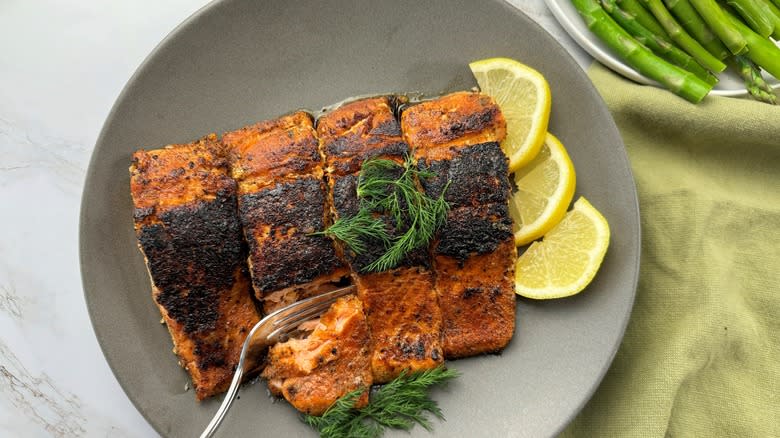
Cajun-style blackened salmon is practically guaranteed to be tasty, but developer De Witt points out that her recipe is also "healthy, easy, and can be on the table in under 15 minutes." She also notes that most if not all of the ingredients called for are the kinds of things you may already have on hand. This means that as long as you've got salmon filets in the freezer (and remember to thaw them out in time), you should be good to go. All you need to do is add a few sides -– De Witt suggests rice, roasted vegetables, or a green salad -– and you'll have yourself a quick, nutritious meal
While Julianne De Witt says this recipe makes four servings, don't pass it up if you'll be eating alone. Not only is it super simple to reduce the recipe, but the leftovers keep in the fridge for up to three days. You can either reheat them by wrapping them in foil and baking them at 300 F or else just enjoy them cold with a squeeze of lemon and a dollop of mayonnaise.
Read more: 15 Different Ways To Cook Fish
Collect The Ingredients For The Blackened Salmon
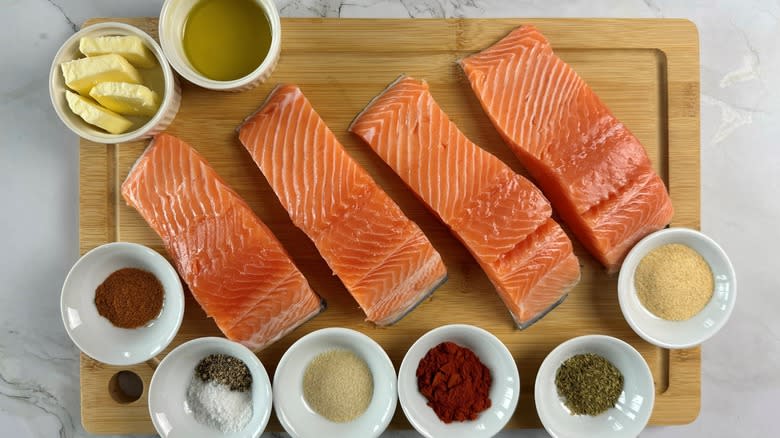
The blackening spice rub, which De Witt says "add[s] a ton of flavor and a touch of heat" is made from smoked paprika, garlic powder, onion powder, cayenne, oregano, salt, and pepper. You'll also need salmon filets, olive oil for cooking, and butter to finish things off.
Step 1: Combine The Blackening Spices
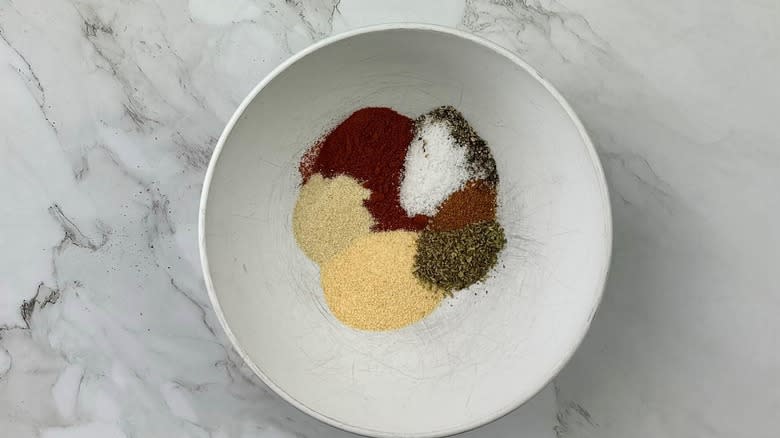
Add paprika, garlic powder, onion powder, cayenne, oregano, salt, and pepper to a small bowl.
Step 2: Mix Up The Spice Rub
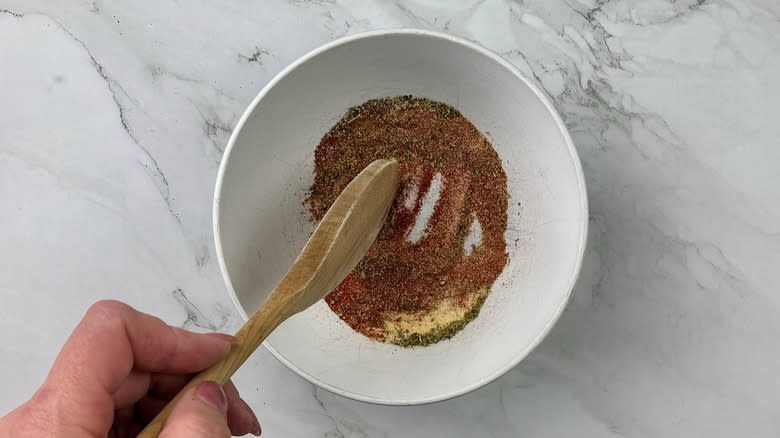
Stir.
Step 3: Season The Salmon
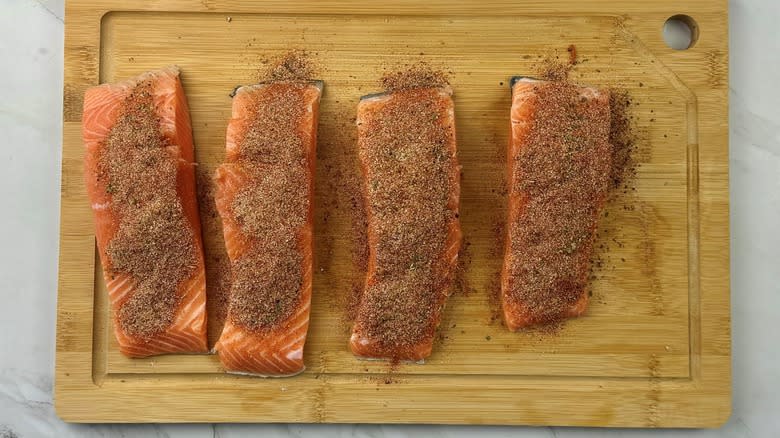
Sprinkle the spice mixture evenly over the salmon filets.
Step 4: Rub The Seasoning Into The Salmon
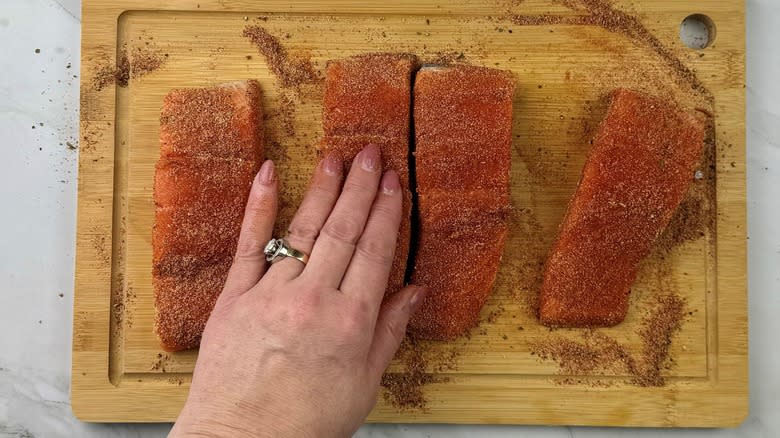
Rub the spices into all sides of the salmon.
Step 5: Heat The Oil
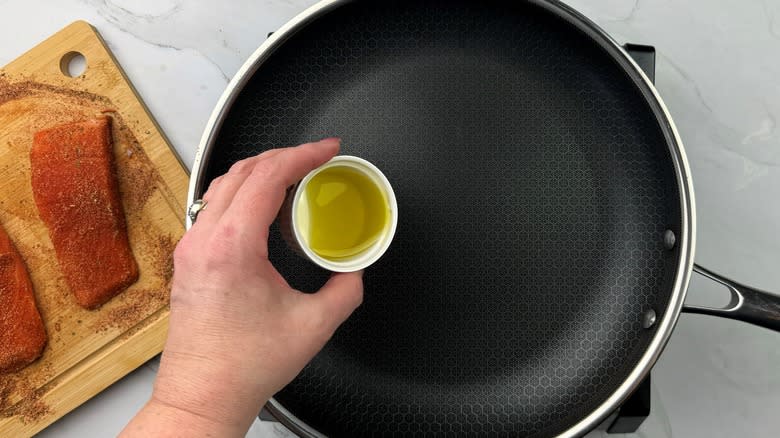
Add the oil to a frying pan over medium-high heat.
Step 6: Fry The Fish
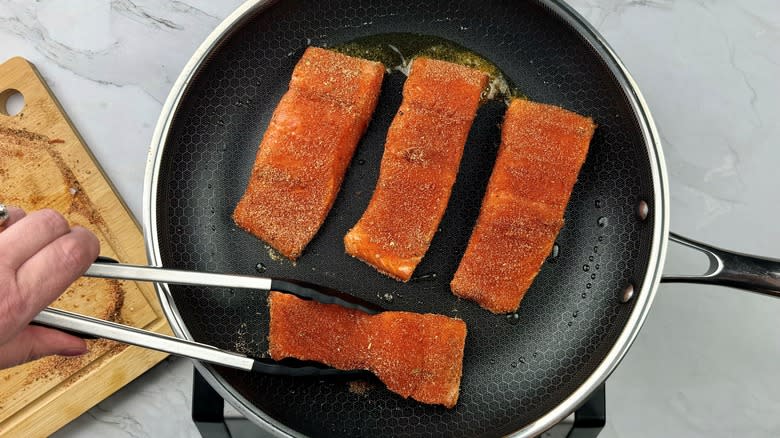
When the pan is hot, add the salmon filets skin-side down and sear for 3–4 minutes.
Step 7: Fry The Other Side
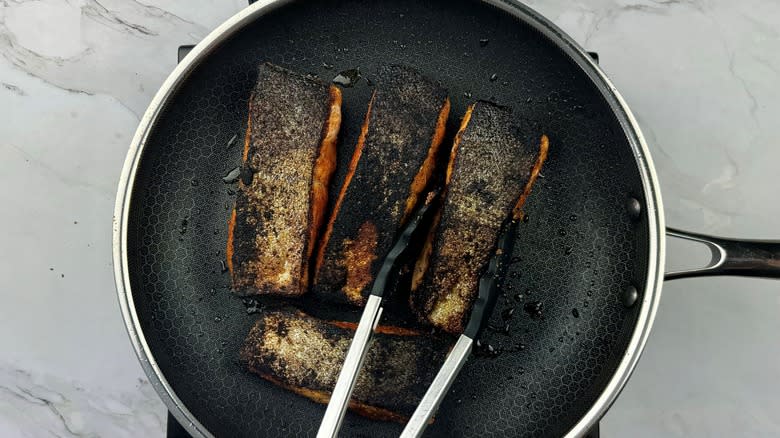
Flip, and continue cooking for an additional 3–5 minutes, depending on the thickness of your filet, until a blackened crust has formed and the internal temperature of the salmon reaches 145 F.
Step 8: Put A Pat Of Butter On Each Piece
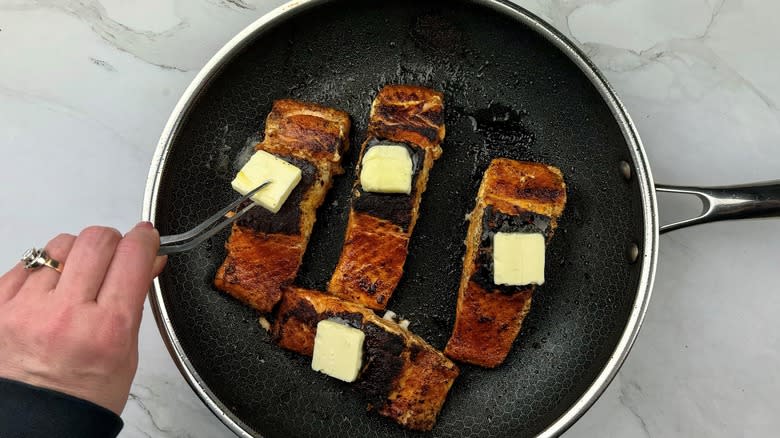
Carefully flip once more so that the salmon is skin-side down. Top each filet with a pat of butter.
Step 9: Wait For The Butter To Melt
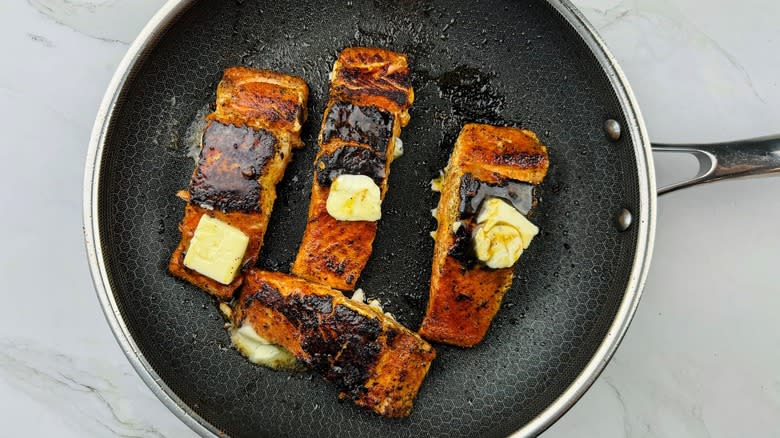
Allow the butter to melt.
Step 10: Serve The Salmon
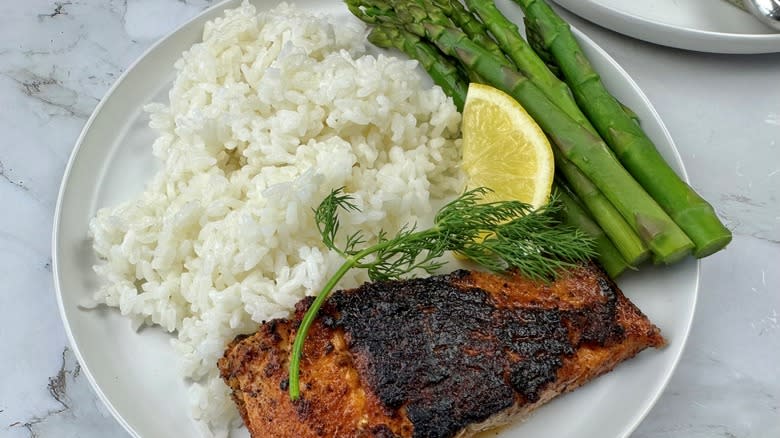
Serve immediately.
What Does It Mean To Blacken The Salmon?
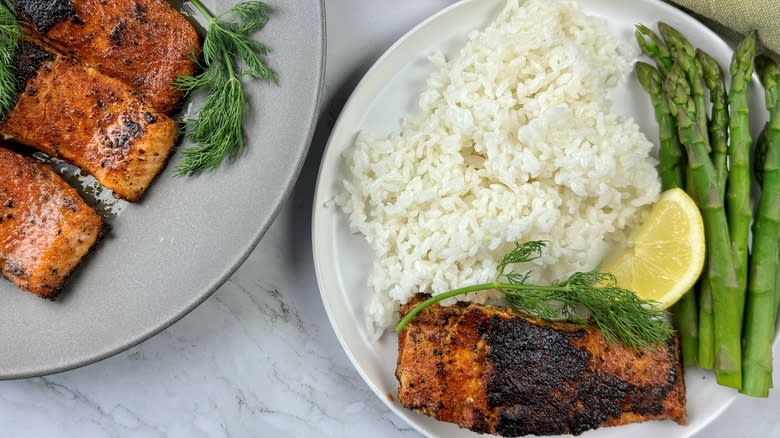
Blackening is a cooking technique that was popularized in the '80s by chef Paul Prudhomme. Blackening may sound similar to charring, but the latter simply cooks food over high heat until the outside surface is just a bit burnt while blackened meat or fish is typically dipped in melted butter or another fat, then coated with a mixture of seasonings before being pan-fried. De Witt, who suggests that you "keep the spice rub your pantry and use it for blackened chicken or steak," skips the butter-dipping step, but she does add some butter once the salmon has finished cooking.
When blackened protein meets a heated pan, it's not so much the surface of the food that turns black but that the spice rub crust does. The blackening helps to deepen the flavor of the seasonings, giving them a slightly earthy taste in addition to the heat and pungency imparted by the individual seasonings. What you don't get is any of the bitterness that would result if the entire dish was burned.
What Kind Of Salmon Works Best For Blackening, And What Are Some Tips For Perfectly Blackening The Fish?
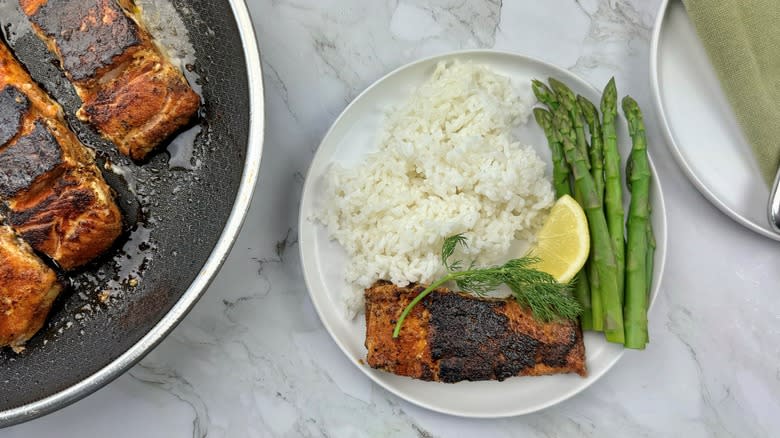
De Witt tells us that she likes to use spring salmon in this recipe, but if you don't see it sold under this name, this type of salmon is also referred to as Chinook or king salmon. She does say, though, that any other kind of salmon will work, as well, whether it be ocean-caught (as is the case with spring salmon) or freshwater. She also tells us that her preference is for individual filets as they are easier to move around in the pan for even cooking, but you can use a larger piece if you want.
Depending on the size of the salmon you use, though, the amount of time it takes to cook may differ from the one given in this recipe. Salmon should reach an internal temperature of 145 F to be safe to eat, so use a meat thermometer to check. De Witt also suggests that you make sure the pan is nice and hot before you put the fish in. Not only will this speed up the cooking, but it will also ensure that the salmon is less likely to stick.
Simple, Classic Blackened Salmon Recipe
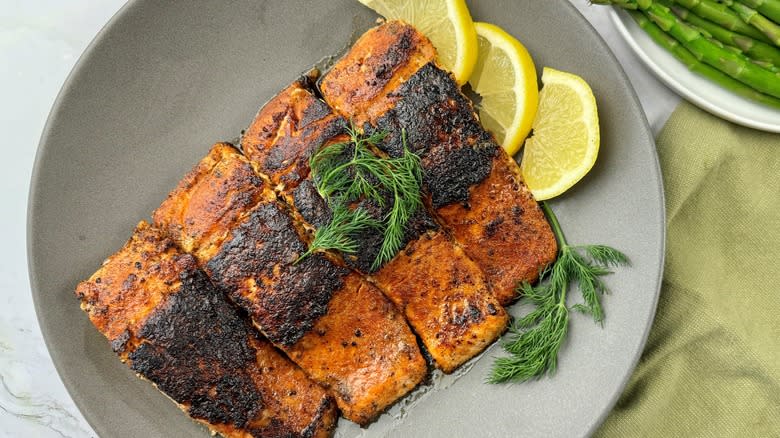
Prep Time: 2mCook Time: 10mYield: 4 servingsIngredients
2 teaspoons smoked paprika
2 teaspoons garlic powder
1 teaspoon onion powder
½ teaspoon cayenne
1 teaspoon dried oregano
1 teaspoon sea salt
½ teaspoon freshly ground pepper
2 tablespoons olive oil
4 (6-ounce) salmon filets
2 tablespoons unsalted butter, divided into 4 pats
Directions
Add paprika, garlic powder, onion powder, cayenne, oregano, salt, and pepper to a small bowl.
Stir.
Sprinkle the spice mixture evenly over the salmon filets.
Rub the spices into all sides of the salmon.
Add the oil to a frying pan over medium-high heat.
When the pan is hot, add the salmon filets skin-side down and sear for 3–4 minutes.
Flip, and continue cooking for an additional 3–5 minutes, depending on the thickness of your filet, until a blackened crust has formed and the internal temperature of the salmon reaches 145 F.
Carefully flip once more so that the salmon is skin-side down. Top each filet with a pat of butter.
Allow the butter to melt.
Serve immediately.
Read the original article on Tasting Table

